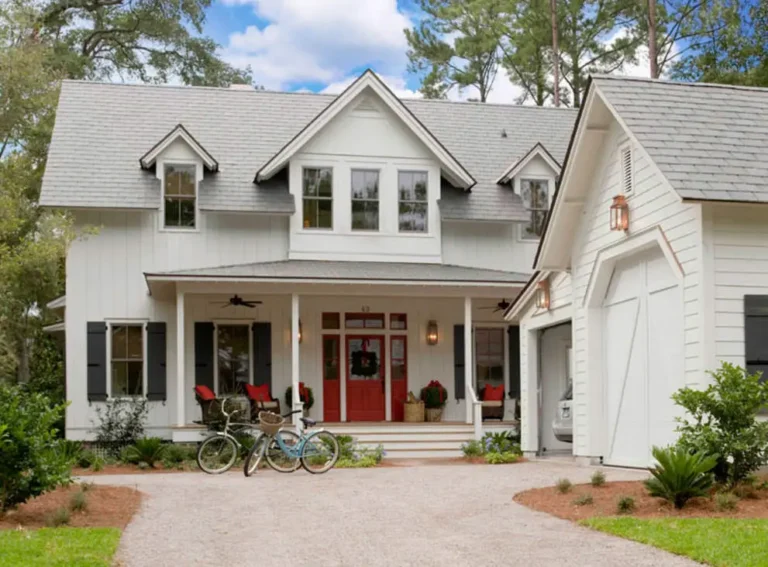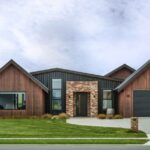Your home’s exterior isn’t just about curb appeal. It’s your first line of defense against weather, insects, and everything Mother Nature throws your way.
When it comes time to replace or upgrade your siding, the options can make your head spin. Fiber cement, vinyl, metal – they all have their fans and critics.
But which one makes sense for YOUR home? That’s what we’re digging into today. I’ve seen hundreds of homes transformed by the right siding choice – and plenty that got it wrong too. Let’s break down these three popular options without the sales pitch or technical jargon.
By the time we’re done, you’ll know exactly which siding deserves a spot on your home.
Which One To Choose Fiber Cement vs Vinyl vs Metal Siding
Choosing the right siding isn’t just about picking a pretty color and calling it a day. Each material brings something different to the table. Fiber cement – think Hardie Board – offers that classic look with serious durability.
Vinyl gives you budget-friendly protection that’s been popular since the 1950s. Metal siding has made a comeback, with sleek modern designs that aren’t just for barns anymore. The right choice depends on your climate, budget, and how much maintenance you’re willing to tackle.
What works for a beach house in Florida might be terrible for a cabin in Minnesota.
Let’s look under the hood of each option so you can make a choice you won’t regret five years down the road.
Understanding the Basics
Fiber cement siding is basically a sandwich of cement, sand, and wood fibers. It’s pressed into boards that can mimic wood, stucco, or even brick. Companies like James Hardie transformed this material in the 1970s, replacing dangerous asbestos with wood pulp. The result? A super tough board that stands up to almost anything.
Vinyl siding is essentially plastic – PVC to be exact. Manufacturers melt down the PVC, add color and UV protectors, then form it into panels. Those panels snap together when installed, creating a waterproof shield around your house. It’s thinner than fiber cement, usually about 0.040 inches thick.
Metal siding comes mainly in aluminum or steel. Steel is heavier and stronger but can rust if not properly protected. Aluminum won’t rust but dents easier. Both come in panels or shingles and can last for decades with minimal care.
Each material has its own personality, just like the homeowners who choose them.
Aesthetic Appeal and Design Options
Fiber cement is the chameleon of siding materials. It can look like traditional wood lap siding, cedar shakes, or even board-and-batten. The texture feels substantial and authentic. You can buy it pre-painted in dozens of colors or paint it any shade you want. Years down the road, when you’re tired of blue? Just paint it green.
Vinyl used to scream “fake plastic house” from a mile away. Not anymore. Today’s vinyl comes in hundreds of colors and decent wood-grain textures. The higher-end stuff can actually look pretty convincing from the street. The catch? Whatever color you pick is what you’re stuck with, as painting vinyl is tricky.
Metal siding has grown up from its utilitarian roots. Modern options include sleek vertical panels for a contemporary look or metal shingles that mimic slate. Colors range from traditional to bold statement hues. The finish can be matte, slightly textured, or even weathered for that trendy industrial vibe. Some metal siding even looks like wood, minus the headaches that come with the real thing.
Your house style matters too – a historic Victorian calls for different siding than a mid-century modern ranch.
Durability and Lifespan
This is where the rubber meets the road for homeowners who hate replacing things.
Fiber cement is basically the tank of siding materials. It doesn’t burn, rot, warp, or get eaten by termites. It laughs at hail that would dent other sidings. With proper installation and minimal maintenance, you’re looking at 50+ years of service. The color may fade eventually, but the material itself just keeps on going.
Vinyl has come a long way but still has limits. Good-quality vinyl won’t rot or rust and generally lasts 20-30 years. But it can crack in extreme cold, and a stray baseball or weed-whacker can punch right through it. It’s also not a fan of extreme heat – I’ve seen vinyl warp just from being too close to a grill.
Metal siding is seriously tough stuff. Properly installed steel or aluminum can last 40-70 years. Steel won’t dent as easily as aluminum or vinyl but might rust if the protective coating gets damaged. Aluminum will never rust but dents if you look at it funny. Both stand up to fire, insects, and most weather conditions like champions.
When you’re talking longevity, fiber cement and metal are playing the long game.
Maintenance Requirements
Let’s be real – nobody wants to spend weekends maintaining their siding.
Fiber cement needs occasional cleaning with a garden hose and soft brush. Every 10-15 years, you’ll likely need to repaint it. Any caulking around windows and doors might need a touch-up every few years. Not zero maintenance, but pretty minimal for something that lasts half a century.
Vinyl is the lazy homeowner’s dream. A yearly cleaning with soap and water keeps it looking fresh. No painting, no sealing, no staining. If a panel gets damaged, you can replace just that section. The only real maintenance is checking for loose panels after big storms.
Metal siding needs almost nothing from you. Occasional washing to remove dirt and checking for scratches in the protective coating is about it. Steel might need touch-up paint if scratches expose the bare metal. The fasteners sometimes need tightening or replacing before the siding itself wears out.
Your time is valuable – factor maintenance hours into your decision alongside dollars.
Energy Efficiency and Insulation
Your siding plays a bigger role in your energy bills than you might think.
Fiber cement doesn’t provide much insulation by itself. It’s dense, which helps somewhat with temperature stability. The real benefit comes when you pair it with proper insulation underneath. It creates a solid barrier that doesn’t expand and contract much with temperature changes.
Vinyl siding comes in insulated and non-insulated versions. Standard vinyl offers minimal insulation value. But insulated vinyl has foam backing that can boost your home’s energy efficiency. The panels create small air pockets that help with thermal regulation.
Metal siding conducts heat and cold efficiently – not great for insulation. Without proper backing, it can make your heating and cooling systems work overtime. The good news? Insulated metal panels exist and work wonderfully. Some metal systems include an airspace between the siding and wall, creating a thermal break.
Remember that your windows, doors, and attic insulation affect energy efficiency as much as your siding choice.
Cost Comparison
Let’s talk money – usually the deciding factor for most homeowners.
Fiber cement sits in the middle price range. Materials run about $5-$11 per square foot installed. The boards themselves aren’t crazy expensive, but installation costs more because the material is heavy and requires special tools. Factor in its long lifespan, and the annual cost becomes quite reasonable.
Vinyl remains the budget champion. Expect to pay $4-$10 per square foot installed. Basic vinyl sits at the lower end, while insulated or premium vinyl pushes toward the upper range. It’s been the go-to for budget-conscious homeowners for decades for good reason.
Metal varies widely based on the type. Aluminum typically costs $3-$9 per square foot installed. Steel jumps to $4-$14 depending on quality and thickness. High-end architectural metal can go even higher. The initial investment stings, but spread over decades of service, metal can be cost-effective.
Don’t forget to calculate long-term value – a cheap siding that needs replacement in 15 years might cost more in the long run.
Environmental Impact
Our planet deserves consideration when making home renovation choices.
Fiber cement has mixed environmental credentials. Manufacturing is energy-intensive and produces carbon emissions. The material lasts forever but isn’t biodegradable. The upside? It doesn’t off-gas toxic chemicals, and its longevity means less frequent replacement.
Vinyl raises some environmental concerns. It’s made from petroleum products and releases dioxins if burned. Manufacturing creates chemical byproducts. Vinyl is technically recyclable but rarely ends up being recycled in practice. Its one green credential is that it requires minimal resources to maintain.
Metal shines in sustainability. Both steel and aluminum are highly recyclable – many metal siding products already contain recycled content. Manufacturing does require significant energy, but the recyclability and longevity offset this somewhat. Metal reflects solar heat, potentially reducing cooling costs in summer.
Your values matter here – weight environmental factors according to what’s important to you.
Installation and Labor
Installation can make or break any siding project.
Fiber cement demands professional installation. The boards are heavy – some weigh 300 pounds per 100 square feet. Cutting creates silica dust that requires respirators and special equipment. Proper installation takes longer but results in fewer callbacks and problems down the road. Expect the installation to take 1-2 weeks for an average home.
Vinyl is more DIY-friendly. The lightweight panels click together like puzzle pieces. You can cut it with regular tools, and one person can handle a panel easily. Even professional installation goes quickly, often finishing in 3-7 days. The tricky part is allowing for expansion and contraction with temperature changes.
Metal siding falls somewhere between the other two. It’s lighter than fiber cement but requires precise installation to prevent oil-canning (waviness in the panels). Metal expands and contracts with temperature changes, so proper fastening is crucial. Most homeowners leave this to professionals, who can usually complete the job in about a week.
Factor installation complexity into your decision, especially if you’re handy and considering doing some work yourself.
Pros and Cons Summary
Let’s boil it down to the essentials.
Fiber cement pros: exceptional durability, authentic appearance, fire-resistant, paintable, resistant to insects and rot, excellent lifespan. Fiber cement cons: higher installation costs, heavier material, requires some maintenance, minimal insulation value.
Vinyl pros: affordable, low maintenance, decent lifespan, available in insulated versions, easy installation, wide color selection. Vinyl cons: can crack or warp in extreme temperatures, not fire-resistant, difficult to repair if damaged, cannot be painted easily, less authentic appearance.
Metal pros: extremely durable, recyclable, low maintenance, fire-resistant, contemporary appearance options, excellent longevity. Metal cons: can dent (aluminum), potential for rust (steel), conducts heat and cold, higher cost for premium options, limited DIY potential.
No perfect siding exists – it’s about finding the right compromise for your situation.
Best Use Cases: When to Choose Each
When should you pick each option? Let me break it down by scenario.
Fiber cement shines for historic renovations or any home where authentic wood appearance matters. It’s perfect in wildfire-prone areas due to its fire resistance. Choose fiber cement if you want something that looks high-end and lasts for generations. It’s also great if you plan to change colors occasionally throughout your home’s life.
Vinyl makes sense for rental properties or when budget is the primary concern. It’s ideal in moderate climates without extreme temperature swings. Pick vinyl if you want the lowest maintenance option and don’t mind replacing it in 20-30 years. It’s also good for DIYers who want to handle their own installation.
Metal siding works beautifully for contemporary or industrial-style homes. It’s perfect for harsh climates with extreme weather conditions. Choose metal if longevity and recyclability top your priority list. It’s also smart in coastal areas where salt spray would destroy other materials.
The best choice matches your specific needs, home style, climate, and budget.
Conclusion
Your siding is more than just the face your home shows to the world. It’s protection, insulation, and a long-term investment rolled into one. Fiber cement offers unmatched durability and authentic looks at a middle-range price point. Vinyl continues to be the affordable, low-maintenance option that works well in many situations. Metal provides exceptional longevity and modern aesthetics for those willing to make the investment.
Take your time with this decision. Drive around neighborhoods you like and note which siding appeals to you. Talk to local contractors about what works best in your climate. Remember that the cheapest option upfront isn’t always the most affordable in the long run.
Whatever you choose, proper installation matters just as much as the material itself. A well-installed modest siding will outperform a poorly installed premium product every time. Your home deserves the best protection you can give it – choose wisely



